Potting Up: What is it and How to Do It
Have you started your indoor seeds already? If so, perhaps you’ve noticed your little plant babies are growing, growing, growing! But, what happens when they outgrow their starting space but the weather hasn’t warmed up enough to plant them outside?
Well, we must pot them up.
If you are new to this process or don’t even know what it is, you’re in the right place. I recently dove into this topic in full detail on the Beginner’s Garden Podcast. You can listen to that episode here or continue reading below.
What is “Potting Up?”
Potting up (or “up-potting,” or “potting on”), is the process of transferring a seedling or small plant into a larger container. This container remains indoors under a grow light until it’s time to transplant into our outdoor garden space.
Why and When is Potting Up Necessary?
Is potting up required? Not always. We often start our seeds, watch them sprout, and then plant them directly into our gardens. But, for many plants, there needs to be a step in between and this is where potting up comes into practice.
Pot up when it’s too soon to plant in the garden
It’s time to pot your plant up when the seedling has outgrown the medium in which it was planted, but it’s too soon to plant the seedling outside in the garden.
This is often the case with tomatoes. The plants have outgrown the growing medium but your average last frost date hasn’t passed yet. Or, nighttime temperatures are still in the 40s, which isn’t the ideal condition for tomatoes to grow. In this case, they cannot sit in the same medium they’ve outgrown; they need more soil, more space, more water, and more nutrients.
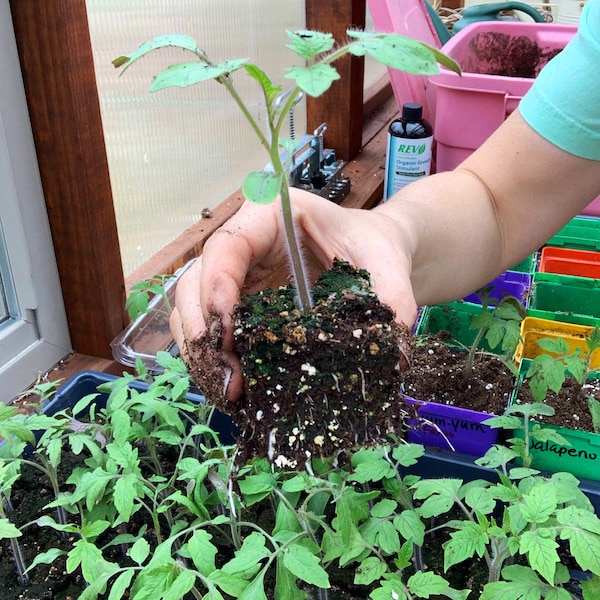
Pot up when seedlings need more nutrients
As plants start to grow true leaves (not the first 2 baby sprout leaves), the plants begin to need nutrients. If we’ve planted our seedlings in a seed starting mix or a potting mix, they won’t get nutrition to further their growth. When you pot up into a container with added fertility (such as a potting mix with added fertilizer), the seedlings access the nutrients they need to grow larger and stronger.
Signs that my seedlings need potting up
Watering Constantly
When you find yourself watering constantly — once per day or more — just to keep the soil moist, your plant is clearly growing. The roots are beginning to take up much more space, absorbing all the water it can. This is a good sign that your plants need to be potted up.

Plants are taller than depth of soil
Another sign that a seedling may need potting up is the height of the plant. If you find that the plant growth above the soil is more than two times taller than the depth of soil, it may be time to pot up.
This isn’t necessarily a hard-and-fast rule, and it will often depend on the kind of plant. For example, lettuce and squash often won’t grow that tall anyway. But for plants like tomatoes and peppers, it’s a sign I’ve learned to pay attention to. Let the plants’ height be a prompt to look for the other signs listed here. A plant’s height is often one of the first indications that potting up should be considered soon.

Plant growth has slowed
If other indicators are present and your indoor-sown seedlings’ growth has stalled — if they still look healthy — it’s likely your plant needs potting up for more space, soil, and nutrition. Some plants like peppers, cabbage, and lettuce are not fussy and will hang out in a small space without any noticeable problem. But once you begin to pot up these plants earlier, you’ll notice a huge difference in growth when they get more space.
Circling Roots
Debatably the most telling sign that a plant has outgrown its container is circling roots. If you grow your plant in a cell pack or container and find when you squeeze the sides that the entire plant can be removed easily and in one piece, it’s an indication that the roots have run out of space to grow. This is a sign that your plant must be potted up soon.
Ideally, you don’t want your crops to get to this point. You want to use the other indicators to pot up before circling of roots occur. But if you find you’ve waited too long, just tease the roots with your fingers to get them less constricted before potting up.
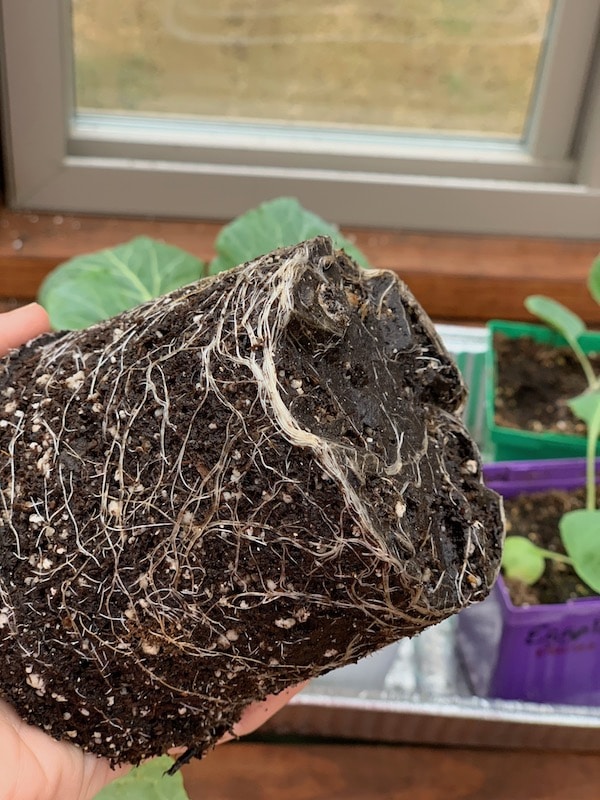
Which crops need potting up almost everytime?
A lot of what you pot up is dependent on when you plant them. So, keep this in mind with any crops. But the crops listed below are ones with long growing times indoors and are ones that are most commonly potted up before outdoor planting:
- Tomatoes
- Peppers
- Cabbage
- Broccoli
- Watermelon
- Squash
- Melons
- Brussels Sprouts
- Celery
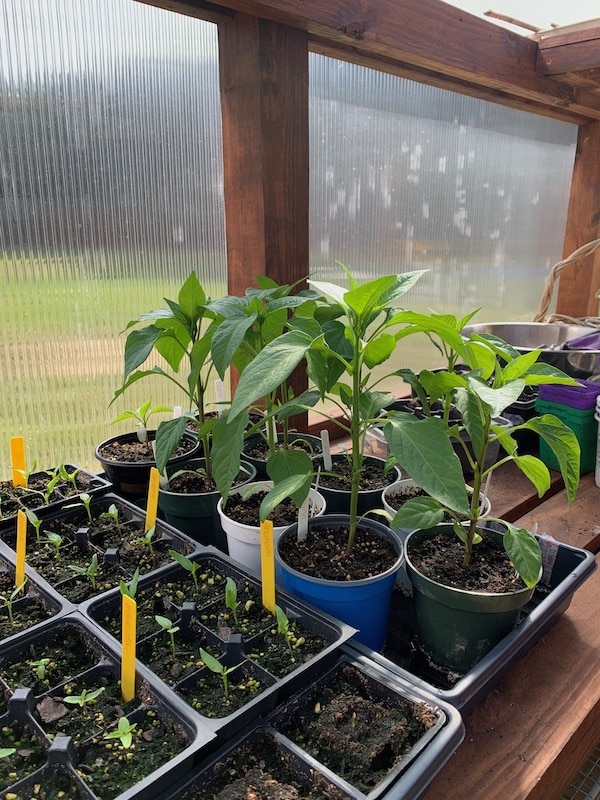
What size container should I use to pot up?
The first step in potting up is choosing the right pot. This is when we use a Goldilocks approach — not too small or too big, but just right.
If you go too small, the plant will quickly outgrow even that container, and you might find yourself potting up a second time. This isn’t necessarily bad for the plant but it’s probably not how you want to be spending your time in the garden.
On the other hand, if you choose a pot too much larger than the space in which the seedling is growing, you run the risk of water management-related root rot.
Let me explain. You transplant your seedling and you thoroughly saturate the soil. But the root system hasn’t grown large enough to be able to absorb the water fast enough. This can cause the soil to become waterlogged. Plants require air to grow well, and soil that is too wet can stunt the plant’s growth and risk rotting some of those roots.
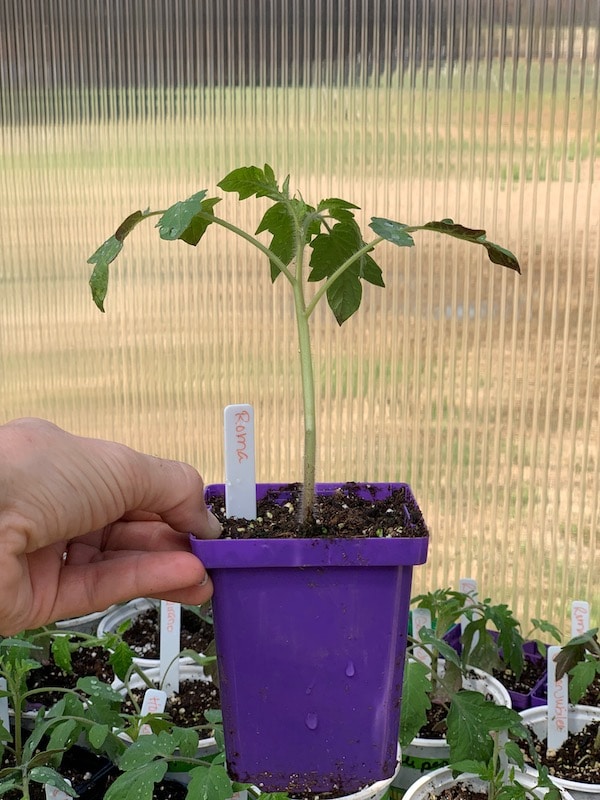
What size is ideal to pot up then? You want to choose a pot or container that is one size up from what you are moving them from. Container “sizes” can vary, though, so my general rule of thumb is to aim for an additional one inch around all sides of the root ball (seedling and soil together). A little deeper is better than to go too wide.
(links below may contain affiliate links, which means if you click through and make a purchase, we will earn a commission at no extra cost to you.)
What potting mix should I use?
When you pot up, use a potting mix with extra nutrients. You can purchase a potting mix with fertilizer mixed in (this one is a favorite of mine). But usually, I purchase a Pro-Mix potting mix and add Espoma Plant Tone to the mix.
How do I pot up?
Though methods of potting up will vary, here are the basic steps I usually follow:
- Add potting mix to the bottom of the container.
- Dip the rootball in Organic Rev (50/50 Rev/water blend, more info here) (optional)
- Remove seedling from container, gently, avoiding tugging at the stem.
- Place it in the pot, holding it upright.
- Top it off with more soil, pressing gently but not packing in.
- Water from the top until it flows out the bottom.
- Put plant back under your grow lights.
Usually after potting up, the seedlings will go through a slight transplant shock. Give them a few days to strengthen up, and you’ll begin noticing new growth within a few days.
Then, get ready to begin the process of hardening off a week or two before planting out in the garden!
Hopefully, I’ve given you a good idea of what potting up is, how to do it and why. As always, I welcome your questions and pictures of your garden. Feel free to tag me on Instagram @thebeginnersgarden.
Do you get overwhelmed with garden planning?

Subscribe here for my best tips to plan your garden in just 7 days -- all for FREE.
Plus, I'll send you my "In the Garden E-mail" on Fridays, periodic updates on garden resources relevant to you, and you'll receive access to my entire bank of free garden downloads!
You are also agreeing to our privacy policy.

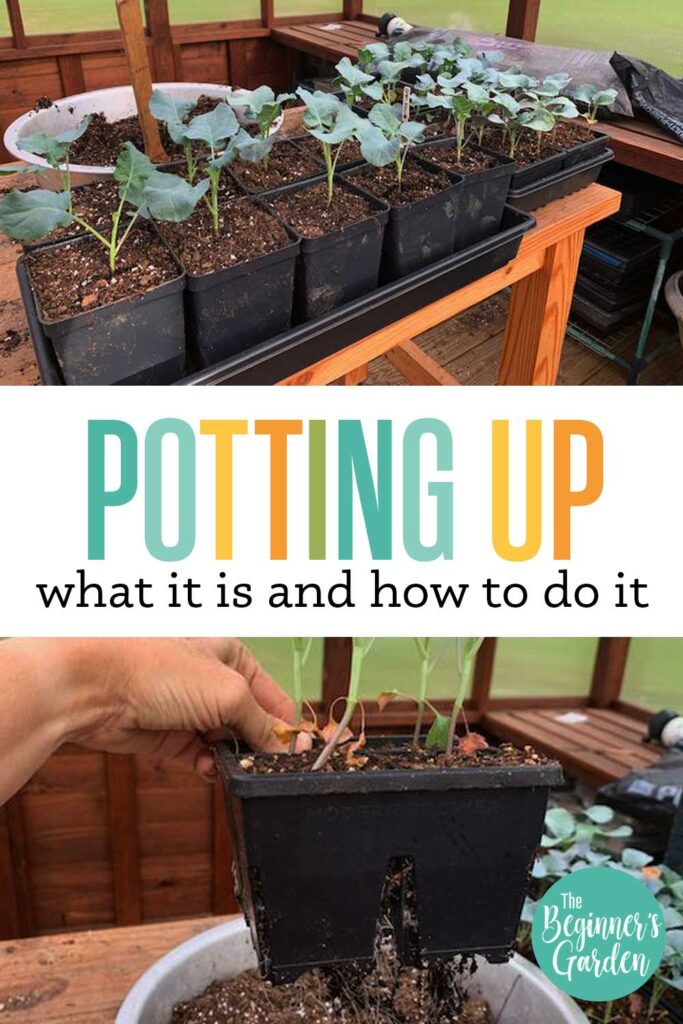
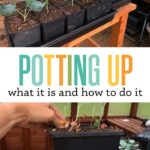
I have these gorgeous tomato plants that have beautiful blooms, but I have not had not even one tomato. I am so frustrated. Is it because it’s to hot? Its an organic garden and has no pests that I can see. ( no munching of leaves etc.)
Most likely, it’s the heat. Most tomatoes won’t set fruit in heat above 90-95 during the day or over 72 at night. Once the temps moderate, fruit will set more easily. Another cause could be too much nitrogen, but unless you fertilized heavily or used a “miracle” soil (which you probably didn’t being an organic gardener), my guess would be the heat.